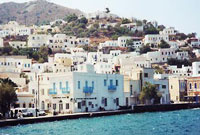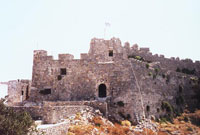 |
|
|
|
| HISTORY
According to the archeological evidence, Leros has been inhabited continuously since the Neolithic era and knew particular prosperity up to the Roman conquest. After that time, it shared the fate of its neighbors, being sold to the Knights of St. John, subjugated by the Turks and occupied by the Italians, who transformed it into a naval base. As a result, Leros was heavily bombarded during World War II. |
|
 |
|
 |
|
SIGHTSEEING
Agia Maria is a traditional settlement displaying local architecture and a number of neoclassical mansions. It is dominated by the castle of the Knights, which occupies the site of the ancient acropolis and was inhabited until the 18th century. Here may be seen the church of the Panayia of the Kastro, backed by picturesque windmills. |
|
| Lakki, the island's main harbor, is know for its carefully planned layout, a heritage of the Italians. Ruins of another ancient acropolis, belonging to the 4th century have also been found on Palaiokastro hill. |
|
| Because of its pleasant tree-filled villages (Partheni, Alinda, Merika) near the sea and its clean beaches easily reached by caique or car, Leros is a fine place to spend a comfortable holiday despite the constantly increasing number of visitors. |
|
 |
|
 |
|
|
|